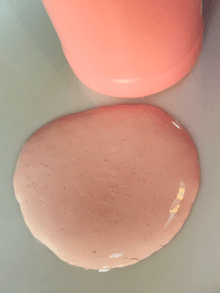Calamine
Calamine, also known as calamine lotion, is a medication used to treat mild itchiness.[2][3] This includes from sunburn, insect bites, poison ivy, poison oak, or other mild skin conditions.[4][5] It may also help dry out skin irritation.[1] It is applied on the skin as a cream or lotion.[2]
 Calamine lotion and container | |
| Combination of | |
|---|---|
| zinc oxide | astringent |
| ferric oxide | antipruritic |
| Clinical data | |
| Pronunciation | KAL a mine[1] |
| Other names | Calamine lotion |
| ATC code | |
Side effects may include skin irritation.[4] It is considered to be safe in pregnancy.[4] Calamine is a combination of zinc oxide and 0.5% ferric oxide (Fe2O3).[6] The lotion is produced with additional ingredients such as phenol and calcium hydroxide.[6][7]
Calamine lotion has been used as far back as 1500 BC.[8] It is on the World Health Organization's List of Essential Medicines for being one of the most effective and safe medicines needed in a health system.[9] Calamine is available over the counter as a generic medication.[5] The wholesale cost in the developing world is about US$0.25–3.85 per 100-ml bottle.[10] In the United Kingdom, it costs the National Health Service about £0.44.[2]
Medical uses
Calamine is used to treat itchiness.[2] This includes from sunburn, insect bite, or other mild skin conditions.[4][5]
FDA
In a 1992 press release, the U.S. Food and Drug Administration announced that no proof had been submitted showing calamine to be effective in treating the irritation of insect bites or stings, or the rashes from poison ivy, poison oak, or poison sumac.[11]
In a September 2, 2008 document, the U.S. Food and Drug Administration recommended applying some topical over-the-counter skin products, such as calamine, to absorb the weeping of the skin caused by poisonous plants such as poison ivy, poison oak, and poison sumac. For relieving the pain or itching caused by these plants, the same document recommends a cold water compress and topical corticosteroids.[12]
References
- "Calamine (topical) medical facts from Drugs.com". www.drugs.com. Archived from the original on 2017-11-05.
- British national formulary : BNF 69 (69 ed.). British Medical Association. 2015. p. 801. ISBN 9780857111562.
- WHO Model Formulary 2008 (PDF). World Health Organization. 2009. p. 303. ISBN 9789241547659. Archived (PDF) from the original on 13 December 2016. Retrieved 8 December 2016.
- "Aqueous Calamine Cream BP - Summary of Product Characteristics (SPC) - (eMC)". www.medicines.org.uk. 18 November 2016. Archived from the original on 30 December 2016. Retrieved 29 December 2016.
- Hamilton, Richart (2015). Tarascon Pocket Pharmacopoeia 2015 Deluxe Lab-Coat Edition. Jones & Bartlett Learning. p. 191. ISBN 9781284057560.
- Braun-Falco, Otto; Plewig, Gerd; Wolff, Helmut Heinrich; Burgdorf, Walter (2012). Dermatology (2 ed.). Springer Science & Business Media. p. 1724. ISBN 9783642979316. Archived from the original on 2016-12-29.
- Ma, Joseph K. H.; Hadzija, Boka (2012). Basic Physical Pharmacy. Jones & Bartlett Publishers. p. 327. ISBN 9780763757342. Archived from the original on 2016-12-30.
- Bendich, Adrianne; Deckelbaum, Richard J. (2016). Preventive Nutrition: The Comprehensive Guide for Health Professionals (5 ed.). Springer. p. 608. ISBN 9783319224312. Archived from the original on 2016-12-30.
- "WHO Model List of Essential Medicines (19th List)" (PDF). World Health Organization. April 2015. Archived (PDF) from the original on 13 December 2016. Retrieved 8 December 2016.
- "Calamine". International Drug Price Indicator Guide. Retrieved 8 December 2016.
- "Banning 415 Ingredients from Seven Categories of NonPrescription Drugs". Press Release. FDA. P92-27. Archived from the original on 13 May 2009.
- September 2, 2008 FDA Document Archived July 16, 2010, at the Wayback Machine